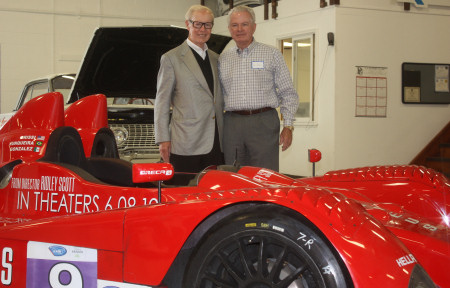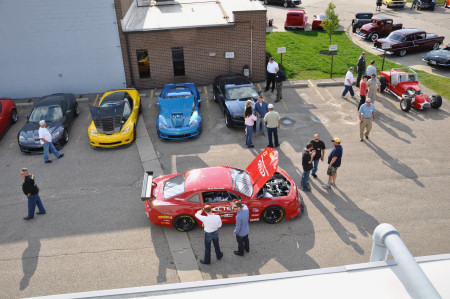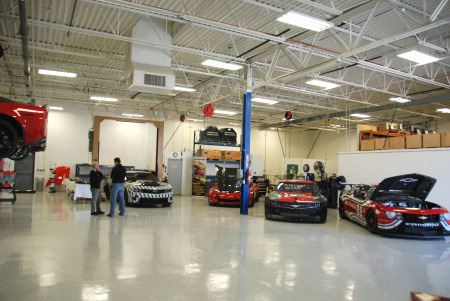The Way It Is/ Pat Patrick's push for natural gasby Gordon Kirby |
 Pat Patrick owned and operated one of Indy car racing's top teams for more than 30 years between 1970-2002. An oil man, Patrick has been in the drilling business for fifty years and like many of his competitors he's expanded in recent years into natural gas. Today, Patrick is the leading exponent of introducing natural gas to motor racing. A few months ago Patrick made an agreement with the ALMS to run natural gas as the fuel for next year's Prototype Challenge category and a couple of weeks ago Patrick announced that Katech engines in Clinton Township north of Detroit has started developing next year's ALMS natural gas Chevrolet engine.
Pat Patrick owned and operated one of Indy car racing's top teams for more than 30 years between 1970-2002. An oil man, Patrick has been in the drilling business for fifty years and like many of his competitors he's expanded in recent years into natural gas. Today, Patrick is the leading exponent of introducing natural gas to motor racing. A few months ago Patrick made an agreement with the ALMS to run natural gas as the fuel for next year's Prototype Challenge category and a couple of weeks ago Patrick announced that Katech engines in Clinton Township north of Detroit has started developing next year's ALMS natural gas Chevrolet engine.
Patrick Racing won 45 USAC and CART races during that time including three Indy 500s in 1973 and '82 with Gordon Johncock and 1989 with Emerson Fittipaldi. Patrick Racing also won the Indy car championship twice with Johncock in 1976 and Fittipaldi in '89. Patrick was also one of CART's founding fathers, working closely with Roger Penske to create the organization and get it up and running. Patrick also created the Indy Lights series in 1985 and brought Firestone back to Indy car racing in 1995. Patrick founded his company Patrick Petroleum in 1962. Patrick was a wildcatter, investing in new wells and exploration, and established himself as one of the most successful independent operators in a tough business. He started his Indy team in 1970 with Johnny Rutherford as his first driver and enjoyed a very successful period through the mid-seventies with STP sponsoring two cars driven by Gordon Johncock and Wally Dallenbach. From 1976-'83 Patrick also built his own cars, called Wildcats, and it was in one of those cars that Johncock scored his second Indy 500 victory in 1982 after a classic duel with Rick Mears.  © Pegasus Marketing Patrick Petroleum carries on however and in recent years Patrick has spent a lot of time trying to convince IndyCar to adopt natural gas as its fuel of choice. But he found no takers at IndyCar and turned instead to the American Le Mans Series where he has been welcomed with open arms. The result is that the ALMS's Prototype Challenge category will run on natural gas next year. Katech hopes to start dyno testing the natural gas-powered LS3 engine in the next month or two with track testing planned for the fall. Last week I discussed Patrick's natural gas initiative with Patrick and his longtime team manager Jim McGee, Indy car racing's most successful crew chief, who is in charge of the project. Patrick said he and McGee turned to the ALMS after they were spurned by IndyCar and the Indianapolis Motor Speedway. "Our company has a lot of natural gas in the ground and the market is not that good for a number of reasons," Patrick explained. "We need to show that natural gas can perform and is safe to use so we can build the market. So we came up with the idea of building a natural gas engine for Indy Lights or IndyCar. "In April, 2009 we signed a contract with Tony George and Brian Barnhart to run natural gas in IndyCar. But then Tony resigned and the contract expired. As far as I was concerned, technically we still had a contract, but the new guy didn't want anything to do with it." Patrick paused and relaxed his jaw a little. "I want to be careful with what I say," he went on. "But Randy Bernard would never respond to my letters about using natural gas to power the Indy Lights series. He wouldn't respond to several phone calls. I don't know the guy, but I'm not very happy with him.  © Pegasus Marketing Jim McGee ran Patrick Racing for many years. McGee was Mario Andretti's chief mechanic in the late '60s during Mario's formative days in Indy cars and ran Roger Penske's Indy car team through the late seventies before joining Patrick. He worked at Newman/Haas in 1993 and '94 running Nigel Mansell's car before rejoining Patrick and spent the bulk of his career with Patrick's team. McGee is the most successful crew chief in IndyCar history with a total of 90 wins. "In IndyCar there isn't anything to sell," McGee observed. "There are no TV numbers, no crowds, no people in the grandstands, no media. The interest level has gone to zero. There are no new innovations coming down the road in racing unless the series determines they're going to have an innovation because the way the rules are written you can't do anything. There's no room to do anything and it's totally stagnant. "On the other hand the ALMS has an open rulebook and they welcomed us. They said, 'Sure we want you. Come on in.' They've said let's prove it in the Prototype Challenge class and then, who knows, maybe we can move up to LMP2 and so on. They don't want to cut out other fuels. They want other fuels and it may come to a point where they would run natural gas against diesel and other fuels and try and come up with an equalizing formula. "The Prototype Challenge category is perfect for us because it's a spec category. All the engines and cars are the same so it's a great place for us to start with natural gas. It'll give the Prototype Challenge a big boost because the cars are using a new innovation." McGee says the initial work to convert Chevrolet's LS3 Prototype Challenge engine to natural gas will be completed at Katech over the next month. Static and dyno testing will then begin followed as soon as possible by track testing of the engine fitted to an Oreca Prototype Chellenge car. "With Katech on board we're really gathering momentum," McGee said. "It's starting to attract a lot of interest. We talked to some people from the Departments of Energy and Transportation and they think it's great that somebody is going to do something to show what natural gas can do. So we're making some strides." Patrick and McGee went to Mid-Ohio the week before last to brief the Prototype Challenge teams on their plans. "We met with the teams at Mid-Ohio to tell them what we're doing and what the benefits will be to them," McGee commented. "We didn't want them to worry about how the program was going to work and how much it was going to cost them. Our goal is to make it work for the competitors so that it doesn't cost them anything and they have the benefit of new sponsors available to them through their association with natural gas. "The producers spend millions of dollars with ANGA, the American Natural Gas Association, and the AGA, the American Gas Association. The producers pay for all the ads you see on TV for natural gas and we've been talking with all the producers, people like Apache, Chesapeake, Southwestern, and these guys love what we're trying to do. They feel like it will bring natural gas more positive attention from John Q. Public.  © Pegasus Marketing McGee discussed the technical challenges faced by Katech in adapting to natural gas. "It's not a big change for the competitors," he said. "We did some early work with Roush but Katech have been working in the ALMS for a long time and everyone has confidence in them, Pat and I included. It's all come together really well. "The engine conversion is not that big a deal. What you want to do is optimize the natural gas whether it's with compression ratios or timing. Natural gas is anti-knock. It doesn't detonate like fossil fuels, whether it's alcohol or whatever. So you can run a lot of spark and a lot of compression with natural gas. "We ran a little 2 liter engine on the dyno at Roush's a couple of years ago. We ran normal spark plugs in it and at twenty pounds of boost it put out 655 hp. It's not rocket science. "We've got a couple of companies working on the tank and delivery system. It's not like it's new technology. It's already out there. It's a matter of downsizing and making it more suitable for racing. We've made some great contacts with these companies and they're willing to supply the equipment at a pretty reasonable price so that everyone benefits." McGee estimates that fuel tank size with natural gas should be roughly similar to gasoline. "Fuel tank capacity should be about what they're using now because LNG is so close to ethanol and alcohol and ten percent off gasoline in terms of BTU values. Plus you have higher octane with natural gas, which is about 130 octane, where alcohol is around 70 and gasoline around 90. "We won't really know until we put the whole package together and do our dyno runs so we can see what the flow rates are and what the engine wants. We'll run the whole system on the dyno as a package with the LNG tank and the delivery system with a heat exchanger, so we get it right before it goes into a car." McGee says natural gas has an image problem when it comes to safety.  © Pegasus Marketing "If you were trying to light it, it takes a gas to oxygen mixture of between five and fifteen percent. So in an open environment it's impossible to ignite because you can't get that type of mixture. Most natural gas explosions happen in a building or underground where the gas is contained and the oxygen level is contained. "When we talked to the people at the DoE and DoT in Washington they said one of the huge things we were going to do for them was to demonstrate the safety of this fuel." Meanwhile, Patrick's frustration with the state of IndyCar cannot be contained. He believes IndyCar should make some major changes if it's to regain its status as a major league American sport. "The Speedway should be the innovator," Patrick said. "They should open up the series to all car manufacturers with stock-block engines. If they don't do something, we're in trouble. Jeff Belskus is a good man. I believe he's going to find the right way forward. He's going to change the way things have been done there." Patrick believes a move to natural gas and stock-block engines would help turn around IndyCar. "Why isn't IndyCar running stock-block engines?" he asked. "That's what I would like to see happen. It costs $35-40,000 for one of those engines and $15,000 for a rebuild after thirty hours. The engines they're working with right now cost $800,000 plus five rebuilds per year. "I'm going to push for this because if we don't we're not going to be talking about IndyCar much longer. They've got to do something and I think they've got to open it up and make it affordable. For some reason the promoters at Indianapolis think the teams have such deep pockets that no cost is too high. Well, that's not true. We may have deep pockets but we're not going to spend $8 million of our own money to go racing when there's so little return. That's the problem. "I'd change the whole structure," Patrick added. "I'd go to stock-block engines, open it up to all the car companies and run it on natural gas. Can you imagine the sponsor potential? Every natural gas supplier would want to get involved. You would attract sponsorship from some major corporations. If you have a little innovation and use your brain you can rebuild it." McGee concluded our discussion about natural gas by sketching the time line of Katech's development program for its ALMS engine. "Probably in the next four weeks we ought to have the engine up and running," McGee said. "Then we'll start working on the delivery system and the tanks. We'd like to have a demonstration vehicle on the track in probably about three months. But we're not going to push this down anybody's throat. We're not going to run it until it's absolutely proven." |
Auto Racing ~ Gordon Kirby Copyright 2012 ~ All Rights Reserved |
